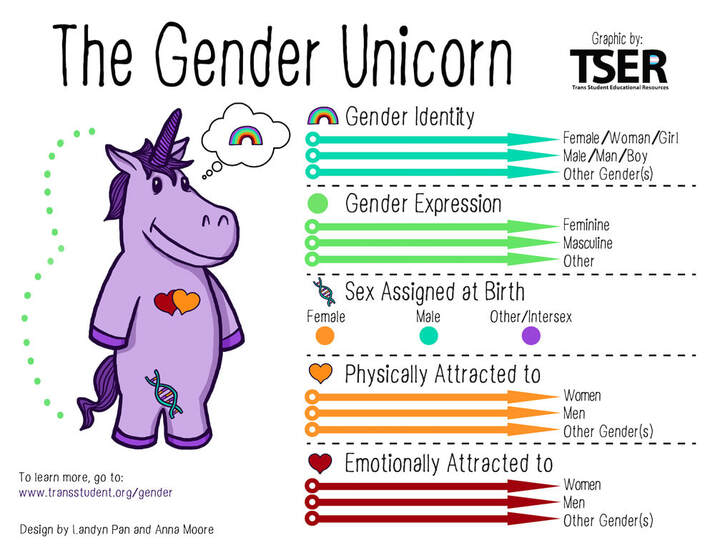|
|
 Trans Student Educational Resources (TSER) created an infographic, The Gender Unicorn, in 2014 to define the spectrums of gender and sexuality. The Gender Unicorn infographic illustrates four main concepts: gender identity, gender expression, sex assigned at birth, and attraction. Each category includes arrows to be used as sliding scales to help us recognize where we fall on each spectrum. Schools and universities often use it as a resource to help educate about gender diversity. Gender Identity: One’s internal sense of being male, female, neither of these, both, and/or other gender(s). Everyone has a gender identity, and for transgender individuals, their sex assigned at birth and their own internal sense of gender identity are not the same. Gender Expression/Presentation: This constitutes how we express or present our gender identity through clothing, hairstyles, make-up, body language, and voice. Every day, we express our thoughts and beliefs about our genders through appearance and behavior that could be classified as feminine, masculine, and/or non-conforming. Sex Assigned at Birth: The assignment and classification of people as male, female, intersex, or another sex based on a combination of anatomy, hormones, and chromosomes. (i.e AMAB - assigned male at birth) Physical Attraction: Sexual orientation. This is a part of our sexual identity that helps define our physical and sexual preferences for relationship partners. Asexuality is one sexual orientation that is used to describe someone who does not experience sexual attraction toward individuals of any gender. It is different from celibacy in that celibacy is the choice to refrain from engaging in sexual behaviors and does not comment on one’s sexual attraction. An asexual individual may choose to engage in sexual behaviors for various reasons even while not experiencing sexual attraction. Emotional Attraction: Romantic/emotional orientation. This describes an individual’s pattern of romantic attraction based on a person’s gender(s) regardless of one’s sexual orientation. For individuals who experience sexual attraction, their sexual orientation and romantic orientation are often in alignment (i.e. they experience sexual attraction toward individuals of the same gender(s) as the individuals they are interested in forming romantic relationships with). Differences between one’s sex assigned at birth and gender identity or expression may lead individuals to experience psychological distress and to be clinically diagnosed with gender dysphoria (Diamond, 2020). According to the DSM-5 TR, some transgender individuals will experience gender dysphoria, which refers to psychological distress that results from an incongruence between one’s sex assigned at birth and one’s gender identity. It can be resolved by altering one’s gender expression to coincide with gender identity, through changes in dress and appearance and, in some cases, by modifying the body through hormones or surgery. This process can be challenging, and unfortunately, gender-diverse youth have higher rates of anxiety, depression, and self-harm, and are disproportionately likely to commit suicide (Newcomb et al., 2020). By recognizing all aspects of our gender identity, we can help reduce stigma and misinformation around the conversation of gender. This is important because LGBTQ youth who live in a community that is accepting of LGBTQ people reported significantly lower rates of attempting suicide than those who do not (The Trevor Project, 2022). Resources:
References:
1 Comment
Today’s LGBTQ workforce has undergone a critical shift in what they demand from organizations. The expectation of workplace inclusion can be seen in how diverse today’s workforce is, especially among the younger generations. Not all organizations are using best practices, however. Many individuals continually experience barriers due to prejudice and discrimination both in the application process and during work. Raising awareness is the first step in creating an inclusive work culture.
Studies show that having diverse teams can help drive innovation and critical thinking when dealing with difficult tasks. And it’s true - people work better when they hear from different perspectives. Each team member brings unique insights from their own experiences to collaborate in a creative way. What LGBTQ workers bring to the job is their resilience, courage, and strong leadership styles. They can empathize with those who struggle from a hostile work environment, and strive to include all employees when they’re in management positions. Each and every organization can benefit from having a diverse and inclusive team. The main problems that LGBTQ workers face are discrimination and a lack of job security. Many are at a disadvantage when applying for jobs because implicit bias can play a big role in the decisions of the hiring managers. Currently, there are no federal laws that protect LGBTQ workers when they’re faced with prejudice and microaggressions. And this happens quite often - more than 40% of lesbian, gay, and bisexual individuals, and almost 90% of transgender persons have experienced discrimination in the workplace, harassment, or mistreatment by co-workers and managers. The Supreme Court ruling that passed last year should, in theory, be a huge step in the right direction. There, however, are still many gaps that need to be addressed with the new ruling. These include a lack of health benefits, enforcement of dress codes, and the lack of appropriate bathrooms. These microaggressions are more subtle yet as devastating as explicit discrimination. Fortunately, there are a number of things leaders can do to make their organizations more LGBTQ-inclusive. First, they must bring awareness to queerness and why it’s important to be authentic. They should listen and take action when employees speak out about issues of discrimination and prejudice. There should also be support systems in place for those who may be feeling isolated such as an HR team that’s dedicated to addressing these types of issues. Diversity and inclusion should always be included in the mission of the organization so that the concept is deeply embedded into the culture and working style of each individual employee. References Graves, L. (2018). Issue at a glance: LGBTQ employment discrimination. Victory Institute. Retrieved from https://victoryinstitute.org/issue-at-a-glance-lgbtq-employment-discrimination/ Levesley, D. (2020). 8 steps leaders can make to make their workplace more LGBTQ-inclusive. The Muse. Retrieved from https://www.themuse.com/advice/steps-leaders-can-take-make-workplaces-more-lgbtq-inclusive The Associated Press. (2020). Even with ruling, workplace still unequal for LGBTQ workers. NBC News. Retrieved from https://www.nbcnews.com/feature/nbc-out/even-ruling-workplace-still-unequal-lgbtq-workers-n1231419 In honor of Pride Month, I would like to discuss why pronouns play such an important role in the LGBTQ+ community. Unfortunately, there are many people that choose to ignore the large impact such a small gesture has on a person experiencing or having experienced gender dysphoria. I’d like to bring up a show that my cousin recently showed me called Pose. This show depicts many instances that the LGBTQ+ community faced on a daily basis during the 1980s. During this time, this community was not as well recognized nor was it as respected as it is today. The characters throughout this show faced discrimination based on both their gender identity and their skin color. I highly suggest watching this show because it gives viewers a better way to understand intersectionality and how addressing someone using the proper pronoun can go a long way.
While watching this show I really liked how the producers acknowledged the internal struggles that transgender women faced. A lot of the women in this show struggled with their identity because they were born into a religious family that did not accept them for who they were and were forced out of their homes because of it. Imagine being forced out of your home because your parents did not want to accept you for simply being you. Pronouns are the first step to showing and affirming the identity of those that are trans especially since they have been told otherwise for so long. Research shows that addressing someone using the correct pronouns has strong psychometric properties in transgender women. It is easy to make an assumption about someone’s gender, but taking that extra step to acknowledge how that assumption can be potentially harmful to someone takes a conscious effort. I feel that being able to take a step back and even correct yourself can mean so much to a person that is constantly being misgendered because of the assumptions people have made about them. It is said that trans individuals are at higher risk for mental health concerns due to the marginalization they face. The LGBTQ+ community simply wants to be acknowledged and seen for who they are instead of constantly being dehumanized when it comes to their sexual identity. People should be able to love who they want to love and identify themselves how ever they please. Our society has so many outdated societal norms that need to be reconstructed. Being able to correctly identify someone should be easy as asking and remembering someone’s name. It is better to ask someone which pronouns they prefer rather than assuming. Bowling, Jessamyn, Barker, Jordan, Gunn, Laura H, & Lace, Tatim. (2020). "It just feels right": Perceptions of the effects of community connectedness among trans individuals. PloS One, 15(10), e0240295–e0240295. Sevelius, Jae M, Chakravarty, Deepalika, Dilworth, Samantha E, Rebchook, Greg, & Neilands, Torsten B. (2020). Gender affirmation through correct pronoun usage: Development and validation of the transgender women's importance of pronouns (TW-IP) scale. International Journal of Environmental Research and Public Health, 17(24), 9525. Our Lady J, Eyrich, L. & Kay, E. (Producers) (2018, June 3). Pose [Television broadcast]. FX Networks. |
Categories
All
Archives
June 2024
|
